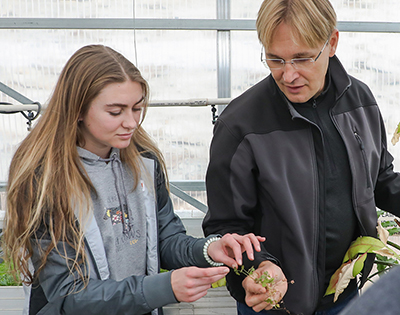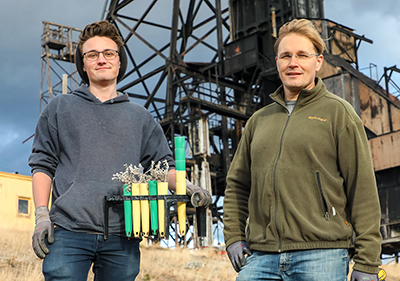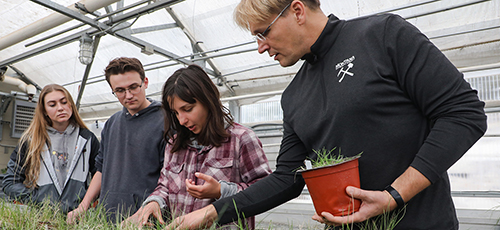Robert Pal - Department of Biological Sciences
 Professor/Director of Restoration
Professor/Director of Restoration
Chemistry & Biology Building (CBB) 218
Phone: 406-496-4725
Email Robert Pal
Biography
View Robert Pal's full biography/CV
Dr. Pal is a Professor and the Director of Restoration at Montana Technological University (Department of Biological Sciences). He holds a master’s in agriculture and a Ph.D. in Biology/Plant Ecology. His main research focus has always been the study of the flora and vegetation of disturbed habitats, including agricultural and urban areas. That led him to work on ecological restoration and plant invasions. He was awarded by prestigious research grants such as the Fulbright Research Grant and the Marie Curie Research Fellowship. He was recently elected a president of the Montana Native Plant Society.
Dr. Pal oversees the Ecological Restoration MS Program, the Restoration Certificate, and the Native Plant Restoration Program at Montana Tech. Besides multiple restoration projects, he is part of several national and international research projects mainly in biological invasions.

Research Interests
As a botanist and plant ecologist, Dr. Pal is fascinated by one of the fundamental questions in ecology: what interactions determine plant distribution and abundance? That governs his research in both plant ecology and ecological restoration.

Much of his research has involved large-scale field experiments to address how abiotic and biotic interactions influence community composition and diversity in anthropogenically impacted and restored habitats. Beside taxonomically based approaches, he is particularly interested in how environmental conditions and human impacts influence functional organization of plant communities.
Another large part of his research focuses on invasion biology. Here he studies evolutionary changes in invasive plant species (e.g. Solidago gigantea, Conyza canadensis), and novel plant-plant, plant-soil, plant-microorganisms and plant-herbivore interactions arising from new invasions on a transcontinental scale.
Restoration Ecology
- Restoration of mining impacted landscapes
- Monitoring
- Restoration seed mix design
- Soil seed bank
- Phytoremediation
Biological Invasions
- Biogeography, phenotypic plasticity
- Plant-plant, plant-soil, plant-microorganisms and plant-herbivore interactions
- Competition, diversity loss
Ecology of Anthropogenic Habitats
- Ecology of arable fields, vineyards
Plant Taxonomy and Syntaxonomy
- Taxonomy of weeds
- Flora and vegetation mapping
- Phytosociological databases
- Weed communities (arable fields, vineyards, and ruderal habitats)
- Red lists
Honors & Awards
- Merit Award for Exceptional Achievement in Teaching, Service, and Scholarship (2020)
- Rose and Anna Busch Faculty Achievement Award for Teaching and Scholarship Excellence (2020)
- Distinguished Researcher Award, Montana Tech (2018)
- Marie Curie Research Fellowship (University of Pécs, University of Montana, 2012-2015)
- Fulbright Researcher Award in the USA (University of Montana, Missoula, 2009)
Career in Brief
Montana Tech
- Tenure-Associate professor, Director of Restoration (2021-)
- Associate professor, Director of Restoration (2018-2021)
- Assistant professor, Director of Restoration (2015-2018)
University of Pécs, Hungary
- Associate professor, Department of Ecology (2013-2015)
- Assistant professor, Department of Plant Systematics and Geobotany (2007-2013)
- Professor’s assistant, Department of Plant Systematics and Geobotany (2006-2007)
- Professor’s assistant, University of Pécs, Institute of Biology, Department of Plant Systematics and Geobotany, 2006-2007
-
Research assistant, Hungarian Academy of Sciences (2003-2006)
Courses Taught
- Restoration I (2015-)
- Restoration Seminar (2015-)
- Restoration II (2016-)
- Restoration Field Practicum (2016-)
- Restoration Capstone (2016-)
- Principles of Habitat Typing (2017-)
- Restoration Field Methods (2020-)

Selected Publications
View Dr. Pal's complete list of publications on his ResearchGate Page.
Nagy D.U., Thoma A.E., Al-Gharaibeh M., Callaway R.M., Flory S.L., Frazee L.J., Hartmann M., Hensen I., Jandová K., Khasa D.P., Lekberg Y., Pal R.W., Samartza I., Shah M.A., Sheng M., Slate M., Stein C., Tsunoda T., Rosche C. (2024): Among-population variation in drought response is consistent across life stages but not between native and non-native ranges. New Phytologist 243(3): 922-935 DOI:10.1111/nph.19895
Hábenczyus A.A., Tölgyesi Cs., Pál R., Kelemen A., Aradi E., Bátori Z., Sonkoly J., Tóth E., Balogh N., Török P. (2022): Increasing abundance of an invasive C4 grass is associated with larger community changes away than at home. Applied Vegetation Science 25:e12659. doi.org/10.1111/avsc.12659
Nagy D.U., Rauschert E.S.J., Callaway R.M., Henn T., Filep R., Pal R.W. (2022): Intense mowing management suppresses invader but shifts competitive resistance by a native to facilitation. Restoration Ecology 30(1): e13483 DOI: 10.1111/rec.13483
Filep R., Lengyel A., Cook B. J., Farkas Á., Nagy K., Nagy D. U., Imri Á., Czakó-Vér K., Pal R.W. (2021): Helianthus tuberosus at home and away: stronger ecological impacts in invaded than in native range are not explained by arbuscular mycorrhizal colonization. Preslia 93: 363–376. DOI: 10.23855/preslia.2021.363
Liao H., Pal R.W., Niinemets Ü., Bahn M., Cerabolini B.E.L., Peng S. (2021): Different functional characteristics can explain different dimensions of plant invasion success. Journal of Ecology: 109:1524–1536. Liao H. and Pal R.W. are joint first authors. DOI: 10.1111/1365-2745.13575
Nagy D.U., Rauschert E.S.J., Henn T., Cianfaglione K., Stranczinger Sz., Pal R.W. (2020): The more we do, the less we gain? Balancing effort and efficacy in managing the Solidago gigantea invasion? Weed Research: 60:232–240 DOI: 10.1111/wre.12417
Osabutey A., Zodrow K., Marques P., Pal R.W. (2020): Amendments Activate Soil Seed Bank in Greenhouse Study, Indicating Potential for Improved Restoration Outcomes. Ecological Restoration. 38(4): 228-236. DOI: 10.3368/er.38.4.228
Pal R.W., Maron J.L., Nagy, D.U., Waller P.W., Tosto A., Liao H., Callaway R.M. (2020): What happens in Europe stays in Europe: apparent evolution by an invader does not help at home. Ecology: 101(8):e03072. DOI: 10.1002/ecy.3072
Nagy D.U., Stranczinger Sz., Godi A., Weisz A., Rosche C., Suda J., Mariano M., Pal R.W. (2017): Does higher ploidy level increase the risk of invasion? A case study with two geo-cytotypes of Solidago gigantea Aiton (Asteraceae). Journal of Plant Ecology 11(2): 317-327.
Maron J.L., Luo W., Callaway R.M., Pal R.W. (2015): Do exotic plants lose resistance to pathogenic soil biota from their native range? A test with Solidago gigantea. Oecologia 179: 447-454.
Pal R.W., Chen S., Nagy D.U., Callaway R.M. (2015): Impacts of Solidago gigantea on other species at home and away. Biological Invasions 17: 3317-3325.
Pal R.W., Csete S., Botta-Dukát Z., Pinke G. (2013): Composition and Diversity of Lawn Flora in Differently Managed Village Yards – A Case Study from Southwestern Hungary. Folia Geobotanica 48(2):209-227.
Pal R.W., Pinke G., Botta-Dukát Z., Campetella G., Bartha S., Kalocsai R., Lengyel A. (2013): Can management intensity be more important than environmental factors? A case study along an extreme elevation gradient from Central Italian cereal fields. Plant Biosystems 147(2): 343-353.
Pal R.W. (2011): Echinaria capitata (Seslerieae, Poaceae), a new grass species for the Hungarian flora. Acta Botanica Hungarica 53(1–2): 175–180.
News Articles
Montana Tech collaborates with Italian university to study Yellowstone National Park fire recovery »
Dr. Robert Pal participates in G-20 Youth Climate Change Panel in India »
Robert Pal Is a Man on a Mission — of Ecological Restoration »
Personal Interests
Robert is a passionate photographer. His photos can be viewed at https://www.flickr.com/photos/robertpal. He also enjoys hiking, skiing, kayaking, fishing, and cooking.